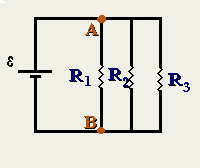Resistors in Parallel:
Above is a schematic of a parallel circuit. Notice the immediate complication. Once the current (i.e. the electrons moving through the conductor) reaches point A, there are now three pathways to get from A to B. So, the current has multiple branching points and each of those branching points routes the current through a different resistory. The values for R1, R2 and R3 are not necessarily the same.
Let's diagnose this circuit in terms of Ohms law and common sense. 1. Clearly, if the current can branch, then its possible (and highly likely) that the current will be different at different places in the circuit. 2. However, since charge is not lost as it travels through the conductor then the sum of current through the three branches has to equal to current that goes into point A (and which comes out at point B). Thus we know that 3.  What about the voltages? Well it turns out that in a parallel circuit,
the Voltages all have to be the same. That is, the potential difference
that exists between A and B is the same, independent of the number of
branching points. If this were not the case, energy would not be
conserved in our circuit. Therefore
What about the voltages? Well it turns out that in a parallel circuit,
the Voltages all have to be the same. That is, the potential difference
that exists between A and B is the same, independent of the number of
branching points. If this were not the case, energy would not be
conserved in our circuit. Therefore
V1/R1 = I1 and we know already that V1 = V. The total current I is I=I1+I2+I3 so to fulfill ohms law for the whole circuit we must have V/R1 + V/R2 + V/R3 = I or 1/R = 1/R1 + 1/R2 + 1/R3 |
